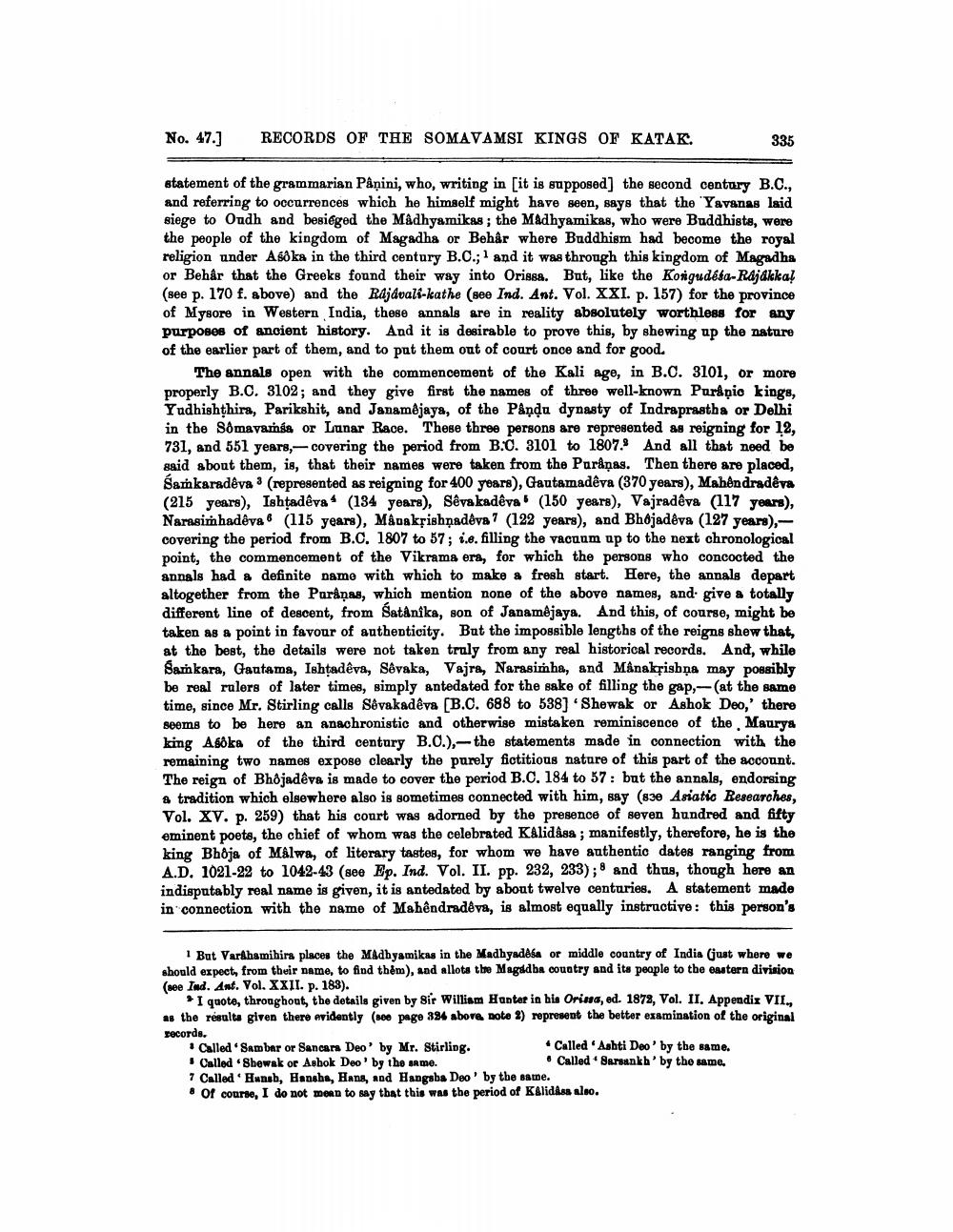________________
No. 47.]
RECORDS OF THE SOMAVAMSI KINGS OF KATAK.
335
statement of the grammarian Pâņini, who, writing in [it is supposed] the second century B.C., and referring to occurrences which he himself might have seen, says that the 'Yavanas laid siege to Oudh and besieged the Madhyamikas; the Madhyamikas, who were Buddhists, were the people of the kingdom of Magadha or Behår where Buddhism had become the royal religion under Asöka in the third century B.C.; and it was through this kingdom of Magadha or Behår that the Greeks found their way into Orissa. But, like the Korgudéta-Rdjákkal (see p. 170 f. above) and the Rajawali-kathe (see Ind. Ant. Vol. XXI. p. 157) for the province of Mysore in Western India, these annals are in reality absolutely worthless for any purposes of ancient history. And it is desirable to prove this, by shewing up the nature of the earlier part of them, and to put them out of court once and for good.
The annals open with the commencement of the Kali age, in B.C. 3101, or more properly B.C. 3102; and they give first the names of three well-known Purinio kings, Yudhishthira, Parikshit, and Janamêjaya, of the Pandu dynasty of Indraprastha or Delhi in the Somayamsa or Lunar Race. These three persons are represented as reigning for 12, 731, and 551 years, - covering the period from B.C. 3101 to 1807. And all that need be said about them, is, that their names were taken from the Paråņas. Then there are placed, Samkaradêva 3 (represented as reigning for 400 years), Gautamadêva (370 years), Mahendradêva (215 years), Ishtadêya* (134 years), Sêvakadêva. (150 years), Vajradêva (117 years), Narasimhadeva & (115 years), Mâoakrishnadeva 7 (122 years), and Bhojadeva (127 years),covering the period from B.C. 1807 to 57; i.e. filling the vacuum up to the next chronological point, the commencement of the Vikrama era, for which the persons who concocted the annals had a definite name with which to make a fresh start. Here, the annals depart altogether from the Paranas, which mention none of the above names, and give a totally different line of descent, from Satánika, son of Janamêjaya. And this, of course, might be taken as a point in favour of authenticity. But the impossible lengths of the reigns shew that, at the best, the details were not taken truly from any real historical records. And, while Sankara, Gautama, Ishtadêva, Sêvaka, Vajra, Narasimha, and Månakrisbņa may possibly be real rulers of later times, simply antedated for the sake of filling the gap,- (at the same time, since Mr. Stirling calls Sevakadêva (B.C. 688 to 538] 'Shewak or Ashok Deo,' there seems to be here an anachronistic and otherwise mistaken reminiscence of the Maurya king Asoka of the third century B.O.),-the statements made in connection with the remaining two names expose clearly the purely fictitious nature of this part of the socount. The reign of Bhojadêva is made to cover the period B.C. 184 to 57: but the annals, endorsing a tradition which elsewhere also is sometimes connected with him, say (838 Asiatic Researches, Vol. XV. p. 259) that his court was adorned by the presence of seven hundred and fifty eminent poets, the chief of whom was the celebrated Kalidasa ; manifestly, therefore, he is the king Bhoja of Malwa, of literary tastes, for whom we have authentic dates ranging from A.D. 1021-22 to 1042-43 (800 Ep. Ind. Vol. II. pp. 232, 233); and thus, though here an indisputably real name is given, it is antedated by about twelve centuries. A statement made in connection with the name of Mahendradêva, is almost equally instructive: this person's
1 Bat Vardhamihira places the Madhyamikas in the Madhyadesa or middle country of India (just where we should expect, from their name, to find them), and allota tbe Magadba country and its people to the eastern division (see Ind. Ant. Vol. XXII. p. 183).
> I quoto, throughout, the details given by Sir William Hanter in bia Orina, ed. 1872, Vol. II, Appendix VII.. as the resulta given there evidently (sce page 894 above note 2) represent the better examination of the original records. • Called. Sambar or Sancars Deo by Mr. Stirling.
• Called Ashti Deo' by the same. Called Shewak or Ashok Deo' by the same.
• Called Sarsankh' by the same. 7 Called. Huneb, Hansba, Hans, and Hangaba Deo' by the same. . Of course, I do not mean to say that this was the period of Kalidasa also.




